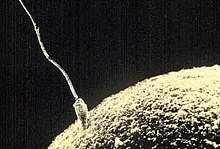Development of the human body
This article needs additional citations for verification. (January 2008) |
Human development is the process of growing to maturity. In biological terms, this entails growth from a one-celled zygote to an adult human being.
Biological development

From a biological standpoint, human development is a continuum, starting with the germ cells (ovum and spermatozoon), through fertilization, prenatal development, birth, and growth to adulthood. The germinal stage, refers to ovum (egg) prior to fertilization, through the development of the early embryo, up until the time of implantation.[1] During this stage, the fertilization creates a single-celled zygote, which is defined as an embyro because it contains a full complement of genetic material. Prior to implantation, the embryo remains in a protein shell, the zona pellucida, and undergoes a series of cell divisions. A week after fertilization the embryo still has not grown in size, but hatches from its protein shell and adheres to the lining of the mother's uterus. This induces a decidual reaction, wherein the uterine cells proliferate and surround the embryo thus causing it to become embeded within the uterine tissue. The embryo, meanwhile, proliferates and develops both into embryonic and extra-embryonic tissue, the latter forming the fetal membranes and the placenta. In humans, the embryo is referred to as a fetus in the later stages of prenatal development. The transition from embryo to fetus is arbitrarily defined as occurring either 8 weeks after fertilization or 8 weeks after implantation. In comparison to the embryo, the fetus has more recognizable external features, and a set of progressively developing internal organs. A nearly identical process occurs in other species, especially among Chordates.
Childbirth is the process in which the baby is born. Age is defined relative to this event in most cultures.
Physical stages of human life
There are no universal definitions for terms of age-related physical development stages, but following are some approximate age ranges:

- Prenatal (fertilization - birth)
- Embryo - fertilization - 8 weeks after fertilization)
- Zygote, the single cell stage which occurs after fertilization
- Blastocyst, the stage prior to implantation, when the embryo is a hollow sphere
- Post-implantation embryo, the period 1 - 8 weeks after fertilization (3 to 10 weeks gestation)
- Fetus, (10th week of pregnancy - birth)
- Embryo - fertilization - 8 weeks after fertilization)


- Child (Childbirth)(0 - 12)
- Neonate (newborn) (0 – 30 days)
- Infant (baby) (0 month - 1 month)
- Toddler (1 – 3 years)
- Play age (4–5 years)
- Primary school age (also called prepubescence) (4-12)
- Elementary school age (also called middle childhood) (4-9)
- Preadolescence (preteen, or late childhood. The child in this and the previous phase are called schoolchild (schoolboy or schoolgirl), when still of primary school age.) (10 – 12 years)
- Adolescence and puberty (13 – 19 years)
- Adult (20+ years)
- Early adulthood (20 – 39 years)
- Middle adulthood (40 – 59 years)
- Advanced adulthood/Senior citizen (60+ years)
- Death (occurs at various ages, depending on person)
- Decomposition (breakdown of the body after death)
Also sometimes used are terms that specify one's age in numbers, such as:
- Child (0-12)
- Teenager (13-19)
- Twentysomething (20-29)
- Thirtysomething (30-39)
- Fortysomething (40-49) (formerly also Quadragenarian, rarely used since 1980)
- Quinquagenarian (50-59)
- Sexagenarian (60-69)
- Septuagenarian (70-79)
- Octogenarian (80-89)
- Nonagenarian (90-99)
- Centenarian (100-109)
- Supercentenarian (110+)
Physical development milestones
- Ability to lift and control the orientation of the head
- Crawling begins
- Walking begins
- Speech begins
- Voice lowers in pitch (especially noticeable in boys)
- Pubic hair appears
- Genitals and reproductive organs mature
- Menstrual cycle begins (females)
- Body hair and facial hair appears ha
Note: the Tanner stages can be used to approximately judge a child's age based on physical development.
See also
- Auxology
- Child development
- Developmental biology
- Embryogenesis
- Life-history theory
- Mammalian embryogenesis
- Memory development
Footnotes
- ^ Gilbert, Scott F. (2003). "Prenatal Development". Human Development (9th ed.). New York, NY: McGraw Hill College. ISBN 978-0072820300.
- ^ Growth of Asthmatic Children Before Long-Term Treatment with Inhaled Corticosteroids T. Moudiou, D. Theophilatou, K. Priftis and A. Papadimitriou, M.D. Journal of Asthma. 2003, Vol. 40, No. 6, Pages 667-671.
- ^ a b Jaffe-Campanacci Syndrome. A Case Report and Review of the Literature. Mohammad Anwar Hau, MBBS, MMed (Ortho), Edward J. Fox, MD, Justin M. Cates, MD, PhD, Brian E. Brigman, MD and Henry J. Mankin, MD. The Journal of Bone and Joint Surgery (American) 84:634-638 (2002)
- ^ Persistent osteopenia in adolescent idiopathic scoliosis (AIS) – Factors predisposing to generalized osteopenia, a cross-sectional and longitudinal investigation Warren T.K. Leea, C.S.K. Cheunga, Y.K. Tsec, W.W. Chaua, L. Qina and Jack C.Y. Chenga. doi:10.1016/j.ics.2006.08.003
